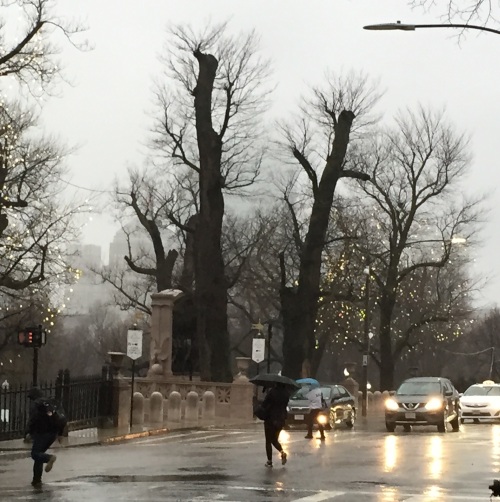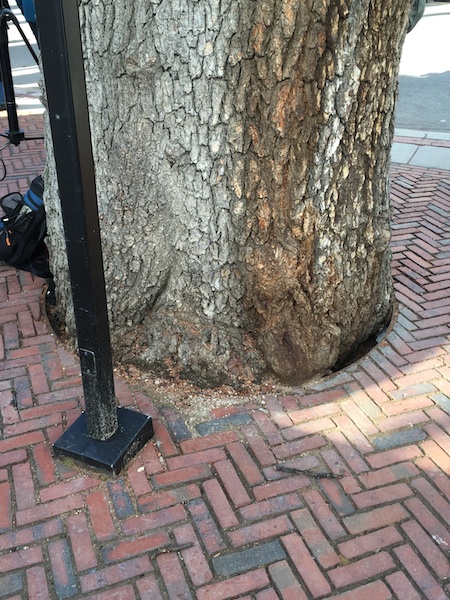A few weeks ago I was on Beacon Hill to run an errand, and snapped a quick shot of the Shaw Memorial elms in the rain:

Looking across Beacon Street to the Shaw Memorial; the two elms flanking the memorial are being managed to retain their trunks’ stability.
It was a soggy, cold day, and I was fast getting soaked, so I didn’t cast around for a better shot. These elms have been standing on Boston Common, across from the Massachusetts State House, for centuries now. This State House (for a long time known as the “New State House”, so as not to confuse it with the original State House on Court Street) was built between 1795 and 1798; the elms date at least to that time, if not to a couple of decades before then.
Elms are a fast growing tree, and before the onslaught of elm bark beetles that brought Dutch elm disease to these parts, Boston Common had a thriving population of elms. (For a good look at the role of the American Elm in history since colonial times, see Tom Campanella’s fine book, Republic of Shade.) The elm stand has been so reduced that now only a few specimens remain; I remember in the summer of 1997 or ’98 watching as a row of elms below the Common cemetery was taken down, tree by tree, as the disease raced from one end of the row to the other.
Henry Davis, owner emeritus of Lowden Tree (now part of SavATree), was landscape consultant to the Friends of the Public Garden for over forty years, and he was responsible for developing the treatment regimen that aimed to save elms as long as possible. Using a combination of pruning and tree injections, he was able to preserve quite a few elms for quite a long time, including these Shaw Memorial trees.
The trees are rooted in the sloping ground now covered by Augustus St. Gaudens’s Robert Gould Shaw Memorial and Massachusetts 54th Regiment Memorial, which commemorates the first documented black regiment formed in the north during the Civil War. The memorial, which includes a two-story retaining wall and St. Gaudens’s relief sculpture, is itself flanked by two broad granite stairways. The elms rise out of a vault under the memorial; maintenance on the lower trunk and roots is performed from inside the vault.

These elms are actually rooted several feet below the memorial’s floor grade, in a vault built into the Common’s slope.
If you saw the last post in this blog, you may understand the thinking behind maintaining the Shaw Memorial elms in this way. These two trees are two of the oldest trees on the Common, and stand as witnesses to American Constitutional history.
A few days after I took the first photo, I spoke to Norm Helie, who now guides the Common’s tree maintenance. Norm told me that he had just had further top weight taken out of the Shaw elms, and the pruning cuts had removed tissue down to sound wood. I made my way down to the Common, and took some more photos — on this day, a demonstration in front of the State House prevented me from repeating the rainy day shot angle, but I was able to get a photo of the new cuts and the State House, to boot:

Thanks Deborah!
Your pics show lots of growing points remaining. Crown retrenchment leads to crown regeneration, and a sustainable future. This is why the German term for this work is translated as “Regenerative Pruning”.
Nice also to see that the sidewalk design allows those bricks at the base to be moved.
Guy, thanks very much for your comment; I always look to you for info on regenerative pruning. Do I recall correctly that you stopped by to see these trees last year?
Reblogged this on Friends of the Public Garden and commented:
The number of people traversing the Boston Common, Public Garden and Commonwealth Avenue Mall may lighten up in winter months, but it is a busy season when it comes to Friends tree care projects, and is a particularly good time for pruning. Crews have been busy over the past few weeks pruning trees, work that will continue throughout winter and into spring. We were getting ready to update everyone on the pruning of the historic elms located at the Shaw Memorial on Boston Common when we came across a wonderful blog post by Deborah Howe. We wanted to share it with you.
I’ve spent a lot of time looking at that statue, but never noticed the trees. Thanks for giving me a new perspective. Now I have to go read about that vault where the roots are. Quite intriguing.